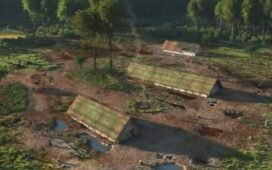Archaeologists digging at the site of a new infrastructure project in Rome have unearthed some lost and forgotten stone walls from a grand medieval palace that was home to the Catholic papacy for nearly 1,000 years, from the fourth through the 14th centuries.
In preparation for the 2025 Catholic Jubilee, a pilgrimage event that takes place periodically in Rome, archaeologists hired by the Italian Ministry of Culture have been carrying out exploratory excavations in the Piazza San Giovanni in Laterno. This is where some of Rome’s most historically significant religious structures are located, including the Basilica of Saint John Lateran, the Baptistery, the Holy Stairs and the Sancta Sanctorum, and the Obelisk.
The infrastructure improvement initiative in the Piazza is designed to make the area more accessible for the millions of worshippers who are expected to visit Rome next year for the Jubilee. As a side benefit, the project has provided a unique opportunity for archaeologists to search for previously undiscovered ruins and artifacts near ancient sacred sites.

Excavations outside the Archbasilica of St. John Lateran in the Piazza San Giovanni in Laterno in Rome. (Courtesy of the Italian Ministry of Culture)
Palace Find Exceeds All Expectations
Expectations were high that these new digs would lead to some fascinating discoveries. But the unearthing of the hidden walls of the ancient home of the papacy managed to exceed those expectations.
The Italian Ministry of Culture said the following in a statement published by Reuters:
“This is an extraordinarily important find for the city of Rome and its medieval history, as no extensive archaeological excavations have ever been carried out in the square in modern times.”
It is believed the walls were constructed sometime in the ninth century. As an addition to the sprawling structure known as the Lateran Palace, these stone walls were apparently defensive in nature. They were likely added to protect the palace and a nearby monumental basilica known as the Patriarchio, both of which were built in the fourth century at the behest of the Roman Emperor Constantine, the first Roman leader to convert to Christianity.
These buildings would have been under threat from Muslim invaders, who were known as Saracens in medieval times. The walls may have also helped guard the palace against armed incursions by ambitious Roman elite factions seeking to gain control over the papacy, which was a threat the early church had to worry about constantly.

The walls appear to have been a defensive structure. (Italian Ministry of Culture)
The Story of Lateran Palace
In 313, Constantine I, or Constantine the Great, issued the Edict of Milan, which called for religious tolerance in the Roman Empire. Not coincidentally, this was one year after the emperor had converted to Christianity, and this edict proved to be the first step in a process that led to the complete Christianization of Roman-controlled lands.
After becoming a Christian, Constantine went on a building spree, and the construction of the Lateran Palace was one of the first projects he initiated. This elaborate structure was designed to be the home of the papacy, and so it was until 1309, when the Holy See relocated to Avignon, France (where it remained until 1376, thanks to intrigue from the French crown that led to the installation of seven consecutive French popes).

A closer look at the walls excavated in the papal structure. (Italian Ministry of Culture)
In 1377 the last Avignon pope, Gregory XI, returned the papacy to Rome. But by this point the Lateran Palace had fallen into disrepair, having been damaged by fire, warfare, natural disasters, and neglect. The papacy chose the Vatican as its new home, and the abandoned Lateran Palace was eventually demolished.
However, in the late 16th century Pope Sixtus V decided to have the palace reconstructed, in acknowledgment of the building’s importance to the Church’s history. In the following centuries it served as a museum, archive, and Catholic hospice, and as a shrine for visitors who wanted to walk in the footsteps of more ancient popes. A bit of additional history was made at the palace in 1929, when it hosted the Lateran Treaty signing ceremony that led to the establishment of Vatican City as an independent state within Italy’s borders.
Today, the Lateran Palace is one of the prize attractions on the Piazza San Giovanni. While it has been meticulously reconstructed and remains exceptionally well-preserved, remnants of the ancient version of this historic structure are still around, hidden from view for centuries but finally accessible thanks to the newest round of excavations at the site. The discovery of the ninth century walls has expanded what is known about the history of the palace, which likely underwent multiple renovations and expansions even before it was abandoned more than 1,700 years ago.
A Celebration for the Catholic Church, and for the Archaeological Community
Interestingly, the newly discovered palace walls are not the only archaeological treasures to be unearthed during preparations for the upcoming Jubilee. Explorations near the Vatican ahead of a road tunnel expansion project uncovered the ruins of an ancient Roman fullonica, or laundry, along with a porticoed garden space believed to have been constructed for the infamous Emperor Caligula. As excavations continue in Rome more amazing discoveries are likely to be forthcoming, perhaps even on the Piazza San Giovanni and around the Lateran Palace.
Top image: Ariel view of the Piazza San Giovanni in Laterano. Source: Courtesy of the Italian Ministry of Culture








